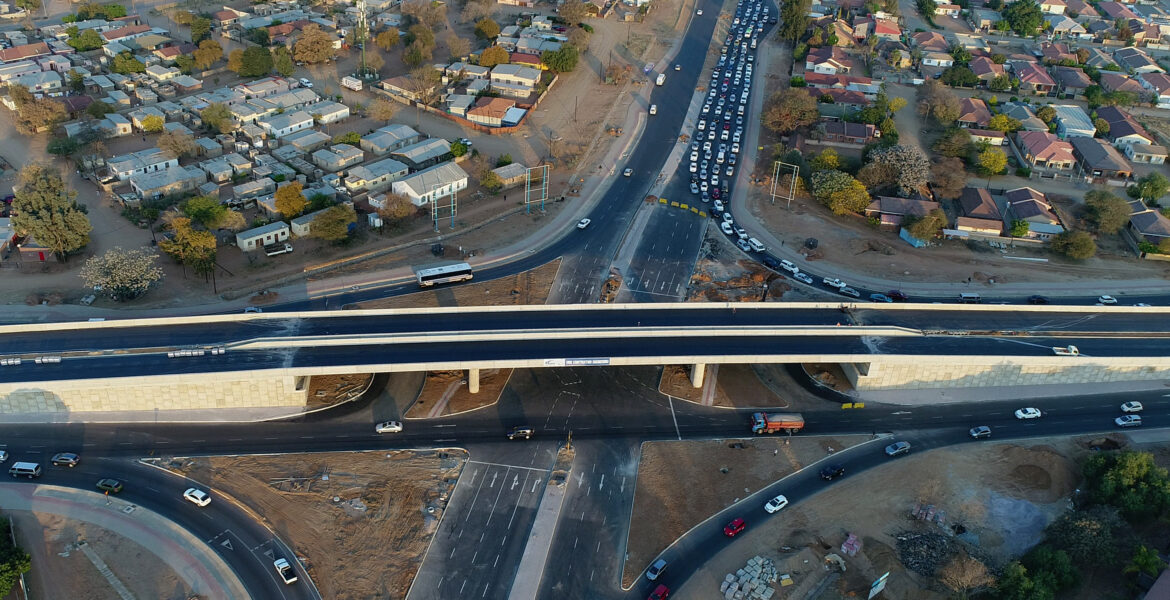DOUGLAS RABASH
Finally after fourteen years of planning and design that started as part of the Botswana Integrated Transport Project BITP in 2009, two of three junctions opened to traffic last Sunday 16th April 2023. The junctions formerly circle and bore their names from the prominent landmarks adjacent to them; Rainbow and BTV Circles. The additional fly over at Game City is yet to open. The contract for three intersections valued at P447 239 902 took four years to complete. We must congratulate the Ministry of Transport, Department of Roads and of course the consulting engineers and contractors for their efforts and diligence in expediting the project.
The Rainbow Flyover – as it may now become known – takes the A1 Western Bypass over the A12 Kudumatse Road – Molepole Road and the BTV Flyover takes the A1 over Willie Seboni Road. The A1 Western Bypass is the most important road in Botswana. The indicative volumes of traffic for the four-lane urban highway with free-flowing conditions (level of service A) is between 30 000 to 60 000 vehicles per day. Given the current traffic volumes on the A1 of about 25 000, the projected traffic increase of around 7 percent pa – LOS A may last for about 7 to 10 years. After that LOS reduces and congestion returns. Let us bear in mind that the project concept was in 2010 and traffic growth in Botswana has been and still is very high.
Obviously the most critical traffic periods are the morning and evening peak hours. The Gazette reporter measured the time taken to travel from Airport Junction to Game City Junction, a distance of 10.6 km at around midday Sunday 23rd April. The time taken to transit the Western Bypass was 9 minutes 46 seconds. All lights were green and the legal speed of 60 kph was not exceeded. The normal time taken to traverse the Western Bypass was 40 minutes during the morning and evening peak hours. Time savings of about 30 minutes are significant as will all other costs associated with road usage benefiting the nation by about P40 million per year – assuming daily traffic flows of 25 000. Other benefits such as lower accidents and emissions from smoother movement, add to the benefits. Given the capital cost of about P450 Million, it can be seen that the payback will be about 12 years, which is pretty good.
The completion and opening of the nation’s third grade separated road intersection will be seen by many as symbolizing development, like high rise buildings, and it is. But developing countries should have passed the point where transport development is seen as big roads and bridges, but it has not. Car ownership rather bus ridership remains the measure of a successful transport policy – and cycling, as a transport mode – well that is totally off the table. The transport planning strategy for Greater Gaborone remains heavily dependent on private cars. The design of these grade separated junctions and indeed most of Gaborone capacity upgrading contributes relatively little to the promotion of public passenger transport, although demarcation of bus lanes is a very welcome addition, provided road users understand them. With a budget of P450 Million, the City could have built 6 bus park and ride stations and added 300, modern 56 seater buses that would have provided a five minute frequency service of each of the radial routes to the centre. Cars would have parked at the park and ride and travelled by bus. Bus lanes should be marked as ‘bus only lanes’ and operating times given on street signage.
Let us hope that the new focus in the Greater Gaborone Multi-Modal Transport Plan of 2022 will be on improving public transport and even non-motorised transport, because building more and more road capacity is neither sustainable nor desirable. Remember as someone once said – ‘building more road capacity in a city is like loosening one’s belt to feel slimmer’.

